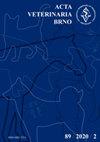MOL-PCR and xMAP technology – a novel approach to the detection of African swine fever virus DNA
IF 0.7
4区 农林科学
Q3 VETERINARY SCIENCES
引用次数: 1
Abstract
African swine fever (ASF) is highly contagious haemorrhagic viral disease of domestic pigs and wild boars. The causative agent can be transmitted by direct contact with infected animals or via a contaminated environment, fomites, feed, meat and products thereof. Soft ticks (genus Ornithodoros) are known reservoirs and transmission vectors of the virus. As the disease causes serious problems in many countries, rapid detection of the agent and early diagnosis could help in prevention of its spread. Therefore, a multiple-analyte profile (xMAP) technology based on multiple oligonucleotide ligation followed by polymerase chain reaction (MOL-PCR) was introduced and verified. A system targeting two independent loci of the virus genome was designed to increase the likelihood of different strains detection and an internal control was employed to verify the correct course of the analysis. The sensitivity was experimentally determined as 10 genomic copies of the virus in one µl of isolated DNA. The system was verified on samples originating from a recent ASF outbreak in the Czech Republic (six spleen) and the Czech market (eight liver and heart tissues) with real-time polymerase chain reaction used as a reference method. The results of both methods were in agreement, even in samples with a low concentration of the virus genome (9.45 × 101 genomic copies/µl of DNA). The system introduced represents an open method allowing the detection and semi-quantification of up to 50 targets/agents in one reaction. It can, therefore, be used for rapid one-step screening and as an effective tool for risk management.moll - pcr和xMAP技术——检测非洲猪瘟病毒DNA的新方法
非洲猪瘟(ASF)是家猪和野猪的高度传染性出血性病毒性疾病。病原体可通过直接接触受感染的动物或通过受污染的环境、污染物、饲料、肉类及其制品传播。软蜱(鸟thodoros属)是已知的病毒宿主和传播媒介。由于该病在许多国家造成严重问题,迅速发现病原体和早期诊断可能有助于预防其传播。为此,提出并验证了基于多寡核苷酸连接后聚合酶链反应(MOL-PCR)的多重分析物图谱(xMAP)技术。设计了一个针对病毒基因组两个独立位点的系统,以增加检测不同菌株的可能性,并采用内部控制来验证分析的正确过程。灵敏度通过实验确定为在1µl分离的DNA中有10个病毒基因组拷贝。对来自捷克共和国最近非洲猪瘟暴发(6个脾脏)和捷克市场(8个肝脏和心脏组织)的样本进行了系统验证,采用实时聚合酶链反应作为参考方法。两种方法的结果是一致的,即使在病毒基因组浓度较低(9.45 × 101基因组拷贝/µl DNA)的样品中也是如此。所介绍的系统代表了一种开放的方法,允许在一次反应中检测和半定量多达50个靶标/试剂。因此,它可以用于快速一步筛查,并作为风险管理的有效工具。
本文章由计算机程序翻译,如有差异,请以英文原文为准。
求助全文
约1分钟内获得全文
求助全文
来源期刊

Acta Veterinaria Brno
农林科学-兽医学
CiteScore
1.00
自引率
33.30%
发文量
36
审稿时长
18-36 weeks
期刊介绍:
ACTA VETERINARIA BRNO is a scientific journal of the University of Veterinary and Pharmaceutical Sciences in Brno, Czech Republic.
The scientific journal Acta Veterinaria Brno is dedicated to the publication of original research findings and clinical observations in veterinary and biomedical sciences. Original scientific research articles reporting new and substantial contribution to veterinary science and original methods that have not been submitted for publication elsewhere are considered for publication. A written statement to this effect should accompany the manuscript, along with approval for publication by the author´s head of department. The authors bear full responsibility for the contents of their contribution. Book reviews are published, too.
 求助内容:
求助内容: 应助结果提醒方式:
应助结果提醒方式:


